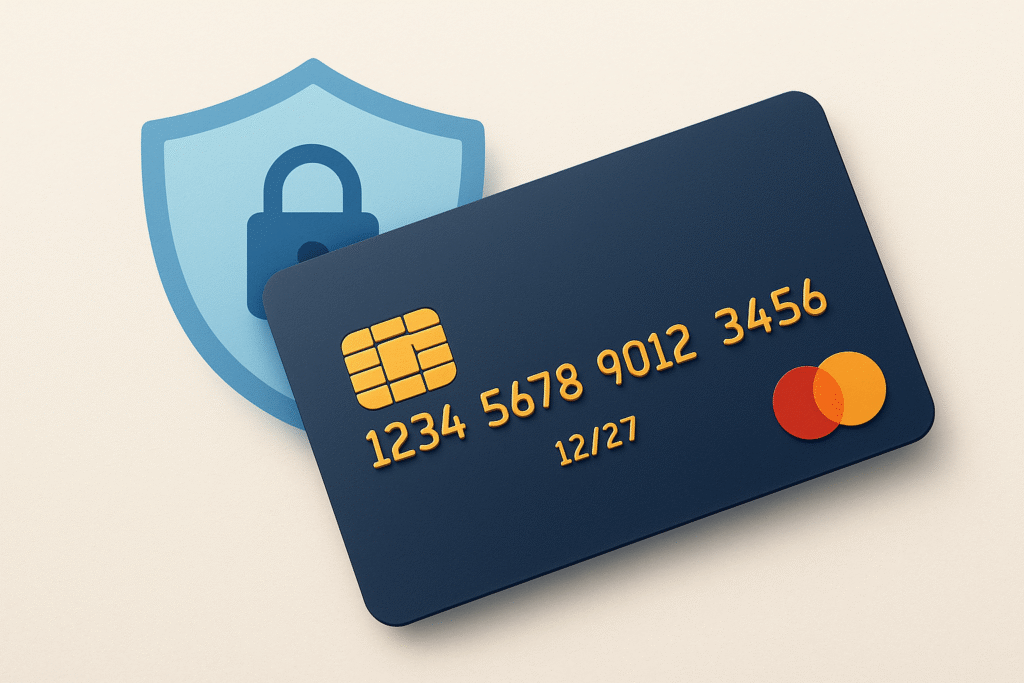Shopping, subscribing, and managing finances online is now the norm. But with convenience comes risk—especially when using your credit card on the internet. Cyber threats are increasingly sophisticated, and data breaches remain a common concern.

Protecting your credit card data online isn’t optional—it’s essential. In this article, we’ll show you how to stay secure, avoid scams, and make safe digital payments.
Why Online Card Security Matters
Cybercriminals are constantly evolving. Credit card fraud, phishing, and data breaches can lead to:
- Unauthorized charges
- Stolen identity
- Damaged credit score
- Lost funds and time
Even large, trusted websites aren’t immune. Taking the right precautions minimizes risk and keeps your information safe.
Common Online Threats
🧨 Phishing Emails & Fake Websites
Scammers imitate legitimate brands, sending emails or links that lead to fake websites designed to steal your card details.
🧨 Data Breaches
Companies and payment processors can be hacked, exposing millions of credit card numbers.
🧨 Malware & Keyloggers
Hidden software records your keystrokes or login information.
🧨 Public Wi-Fi Risks
Hackers can intercept your data on unsecured networks like those in cafes or airports.
10 Smart Tips to Protect Your Credit Card Online
1. Use a Virtual Credit Card Number
Some banks and fintechs offer virtual cards for online shopping. These generate a temporary number that links to your main account but can’t be reused.
- Offered by: Revolut, Capital One, Wise, and more
- Perfect for: Single-use purchases or subscriptions
2. Enable Two-Factor Authentication (2FA)
Protect your banking and shopping accounts with 2FA. Even if someone steals your password, they can’t log in without the second verification step (e.g., SMS code or app notification).
3. Use Secure, Trusted Websites
Only enter your card details on sites that:
- Start with https (the “s” means secure)
- Have a padlock icon in the browser bar
- Come from verified merchants
Avoid sketchy URLs or offers that sound too good to be true.
4. Never Save Your Card on Shared Devices
Don’t allow browsers to save your credit card info—especially on public or shared computers.
Tip: Use a secure password manager instead to store credentials safely.
5. Monitor Transactions Regularly
Check your credit card app or bank account daily. Set up real-time alerts for every purchase. This way, you can spot and report unauthorized transactions immediately.
6. Use Mobile Wallets When Possible
Apps like Apple Pay, Google Pay, and Samsung Pay use tokenization, meaning your card details are never shared with merchants.
They’re often safer than typing in your card details manually.
7. Avoid Public Wi-Fi for Transactions
Never shop or enter card info on unsecured Wi-Fi. Use a VPN (Virtual Private Network) or your mobile data instead.
8. Limit the Sites That Store Your Card
Only allow secure, trusted websites to save your payment details. Periodically review your saved cards and remove any you don’t recognize or no longer use.
9. Watch for Subscription Traps
Free trials often require a credit card and may start charging you automatically. Set reminders or use a virtual card with a spending limit for these services.
10. Know How to Report Fraud
Act fast if you suspect fraud:
- Freeze or lock your card instantly via your bank app
- Report the charge and request a new card
- Check if your card offers zero liability protection for fraud
Bonus Tip: Use Prepaid or Digital Cards for Online Shopping
Prepaid cards or digital-only cards like those from Wise or Revolut can help you avoid exposing your main credit account.
These cards often let you:
- Set spending limits
- Create disposable numbers
- Disable online transactions instantly
Final Thoughts
Protecting your credit card data online means combining smart habits, the right tools, and awareness of digital threats. While no system is 100% bulletproof, these tips will reduce your risk dramatically.
Stay informed, monitor your accounts, and use security features your card and apps provide. With the right approach, you can enjoy all the benefits of digital payments—without the fear.
